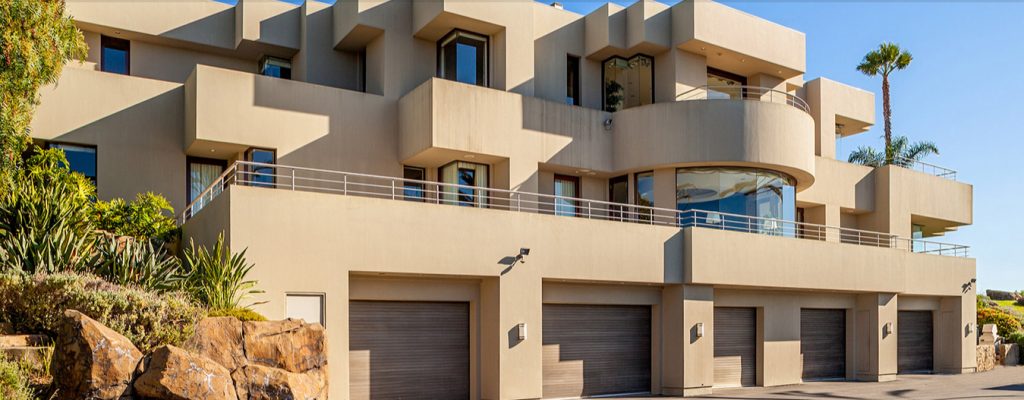
A 20-year-old mansion in California is the last big piece of LandAmerica’s bankruptcy estate. Photos courtesy of Platinum Luxury Auctions.
Nearly seven years after signaling the beginning of the end for what was once one of Richmond’s largest corporations, the long-running bankruptcy case of LandAmerica Financial Group is finally headed toward a conclusion.
The trustee overseeing the LFG bankruptcy estate said in an interview last week that he expects to distribute the last of the recovered funds to the company’s creditors in November or December. LFG was the largest of more than half a dozen LandAmerica entities that went into Chapter 11 as the overall firm toppled in late 2008.
“We are wrapping it up,” said trustee Bruce Matson, who is also a LeClairRyan attorney. “It’s time to close the case and make a final distribution.”
In the end, the overall payouts should amount to about 80 cents on the dollar and a total of $500 million, which Matson said is a success in such a large case and the result of years of selling off assets and suing all sorts of people and companies to collect as much money as possible for LFG’s many creditors.
But there’s still one jewel that must be unloaded before creditors can begin getting some of their money back – and it’s a flashy one.
Matson is working to sell a palatial home on the Pacific Coast that is the last major asset in the bankruptcy estate and could result in one final pot of cash to go back to creditors.
The 24,000-square-foot home sits at 19101 Fortuna Del Este in Escondido, California, atop a hill overlooking the Pacific Ocean. The San Diego County locality is a ritzy retreat for celebrities – last fall, Bill Gates bought a mansion there from Jenny Craig for $18 million.

In addition to the giant pool, the home has a 20-car garage, a Japanese grill, a theater and a fitness center.
The 18-acre LandAmerica property boasts a pool running through the center of the home, among other lavish amenities.
“It’s quite a property,” Matson said. “Most people who look at it would say, ‘How did this end up as part of LandAmerica?’
“It’s complicated, but it tells you a lot about LandAmerica.”
As the story goes, LandAmerica once owned a bank out west called Centennial Bank. It made the loan that the home’s previous owner used to buy the property.
As part of LandAmerica’s bankruptcy, it sold Centennial Bank to the tune of about $60 million in 2013, Matson said. But the bank’s buyer didn’t want to take on the Escondido loan. The property eventually became controlled by California’s state insurance commissioner, until Matson used a lien to regain the asset for the bankruptcy estate.
Now the home is set for auction Sept. 19 after having previously been on the market for $12.5 million. The auction listing states that it will be sold at or above $5 million.
When the LFG case does finally come to a close, Matson and his team will have recovered about $500 million in assets for the company’s list of creditors, the largest of which are banks, bond holders and other institutional holders. Matson said some of the largest sources of recovered funds came from the sale of Centennial Bank, a large settlement from a lawsuit against LFG’s former executives and directors, a $169 million tax refund and the pending sale of the mansion.
The case’s pending conclusion also means the end of a gift that has kept on giving to the Richmond legal industry.
LFG’s Chapter 11 case alone has led to more than 5,700 entries in the federal docket since November 2008. Dozens of lawyers representing the dozens of interested parties have worked the case over the years. That’s not including the bankruptcies of other affiliates and the countless lawsuits related to each case.
Matson said he and his team have spent thousands of hours on the case.
“I’ve worked on this case for six years, and out of those six years, two or three of them I was 80 percent occupied with LandAmerica.”
That all adds up to a truckload of billable hours to the law firms, accountants and other professional services firms that were hired to unravel the case, as is typical in large corporate bankruptcies.
Still, Matson, who has been in bankruptcy law for three decades and has worked some of the biggest bankruptcy cases in Richmond, considers it an enormous success for LFG creditors, who at the start of the case were told they’d get back around 30 cents on the dollar.
“I don’t want to suggest otherwise – it was an expensive case,” Matson said. “But sometimes you get what you pay for. There were good professionals working the case figuring out fair resolutions.”
The resolutions of LFG’s assets is separate from that of LandAmerica Exchange Services, the other large piece of LandAmerica. LES specialized in handling proceeds for individuals who sold real estate through 1031 exchanges. The creditors in that side of the bankruptcy were largely individuals, rather than corporations, and have since been repaid 100 percent of what they were owed.

A 20-year-old mansion in California is the last big piece of LandAmerica’s bankruptcy estate. Photos courtesy of Platinum Luxury Auctions.
Nearly seven years after signaling the beginning of the end for what was once one of Richmond’s largest corporations, the long-running bankruptcy case of LandAmerica Financial Group is finally headed toward a conclusion.
The trustee overseeing the LFG bankruptcy estate said in an interview last week that he expects to distribute the last of the recovered funds to the company’s creditors in November or December. LFG was the largest of more than half a dozen LandAmerica entities that went into Chapter 11 as the overall firm toppled in late 2008.
“We are wrapping it up,” said trustee Bruce Matson, who is also a LeClairRyan attorney. “It’s time to close the case and make a final distribution.”
In the end, the overall payouts should amount to about 80 cents on the dollar and a total of $500 million, which Matson said is a success in such a large case and the result of years of selling off assets and suing all sorts of people and companies to collect as much money as possible for LFG’s many creditors.
But there’s still one jewel that must be unloaded before creditors can begin getting some of their money back – and it’s a flashy one.
Matson is working to sell a palatial home on the Pacific Coast that is the last major asset in the bankruptcy estate and could result in one final pot of cash to go back to creditors.
The 24,000-square-foot home sits at 19101 Fortuna Del Este in Escondido, California, atop a hill overlooking the Pacific Ocean. The San Diego County locality is a ritzy retreat for celebrities – last fall, Bill Gates bought a mansion there from Jenny Craig for $18 million.

In addition to the giant pool, the home has a 20-car garage, a Japanese grill, a theater and a fitness center.
The 18-acre LandAmerica property boasts a pool running through the center of the home, among other lavish amenities.
“It’s quite a property,” Matson said. “Most people who look at it would say, ‘How did this end up as part of LandAmerica?’
“It’s complicated, but it tells you a lot about LandAmerica.”
As the story goes, LandAmerica once owned a bank out west called Centennial Bank. It made the loan that the home’s previous owner used to buy the property.
As part of LandAmerica’s bankruptcy, it sold Centennial Bank to the tune of about $60 million in 2013, Matson said. But the bank’s buyer didn’t want to take on the Escondido loan. The property eventually became controlled by California’s state insurance commissioner, until Matson used a lien to regain the asset for the bankruptcy estate.
Now the home is set for auction Sept. 19 after having previously been on the market for $12.5 million. The auction listing states that it will be sold at or above $5 million.
When the LFG case does finally come to a close, Matson and his team will have recovered about $500 million in assets for the company’s list of creditors, the largest of which are banks, bond holders and other institutional holders. Matson said some of the largest sources of recovered funds came from the sale of Centennial Bank, a large settlement from a lawsuit against LFG’s former executives and directors, a $169 million tax refund and the pending sale of the mansion.
The case’s pending conclusion also means the end of a gift that has kept on giving to the Richmond legal industry.
LFG’s Chapter 11 case alone has led to more than 5,700 entries in the federal docket since November 2008. Dozens of lawyers representing the dozens of interested parties have worked the case over the years. That’s not including the bankruptcies of other affiliates and the countless lawsuits related to each case.
Matson said he and his team have spent thousands of hours on the case.
“I’ve worked on this case for six years, and out of those six years, two or three of them I was 80 percent occupied with LandAmerica.”
That all adds up to a truckload of billable hours to the law firms, accountants and other professional services firms that were hired to unravel the case, as is typical in large corporate bankruptcies.
Still, Matson, who has been in bankruptcy law for three decades and has worked some of the biggest bankruptcy cases in Richmond, considers it an enormous success for LFG creditors, who at the start of the case were told they’d get back around 30 cents on the dollar.
“I don’t want to suggest otherwise – it was an expensive case,” Matson said. “But sometimes you get what you pay for. There were good professionals working the case figuring out fair resolutions.”
The resolutions of LFG’s assets is separate from that of LandAmerica Exchange Services, the other large piece of LandAmerica. LES specialized in handling proceeds for individuals who sold real estate through 1031 exchanges. The creditors in that side of the bankruptcy were largely individuals, rather than corporations, and have since been repaid 100 percent of what they were owed.



Nice report. Would really like such a follow piece with the Trustee for Circuit City, too. CC entered bankruptcy in early 2009 and is still slowly doling out drips and drabs to creditors.